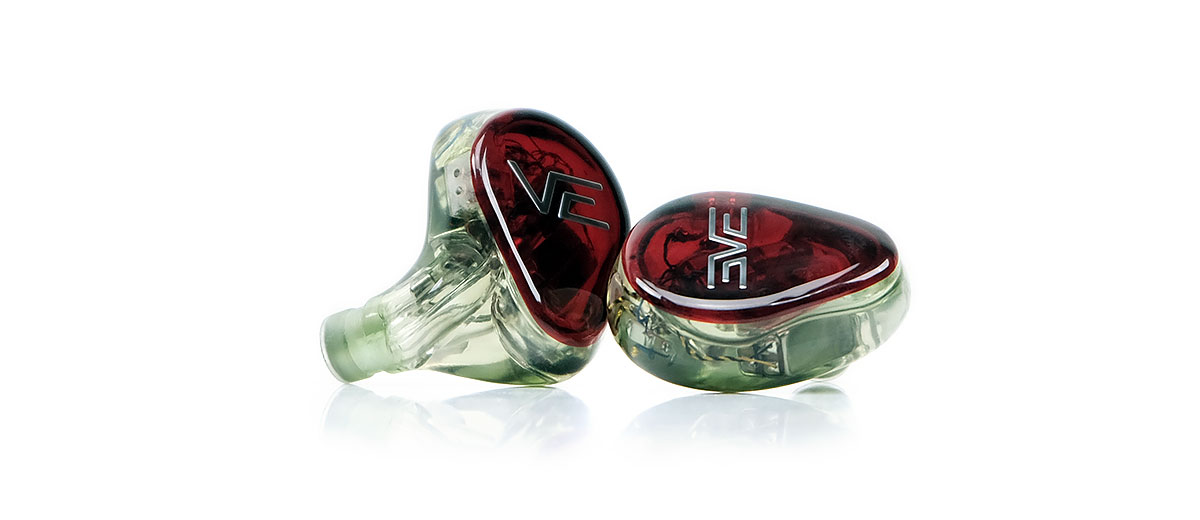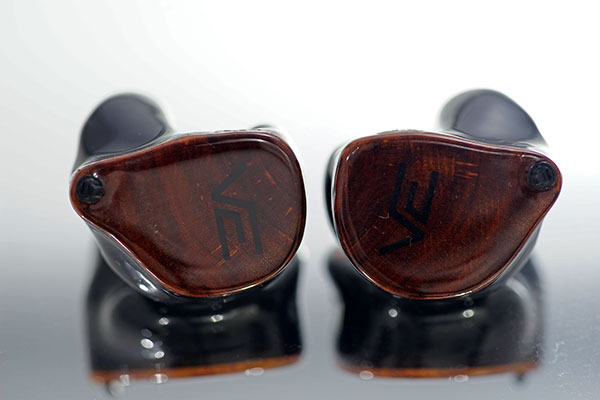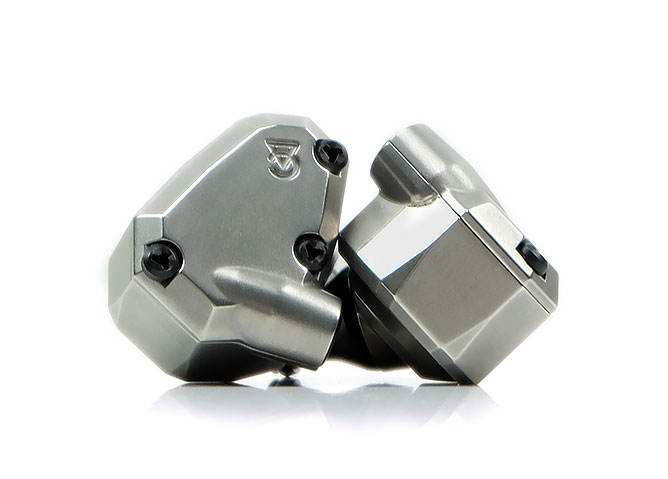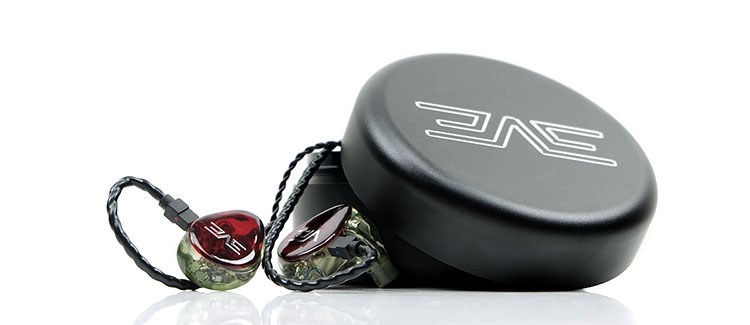EVE20 Sound Impressions
Summary
This is a beautiful but complex sound signature that sits somewhere between the more intimate VE6 X1 and the more explosive VE8. It has some heft and power but a slightly sweeter and more pristine overtone that sounds more relaxed than the VE8 but also technically more precise and airier than the VE6.
The EVE20 does have a weighted low-end with some mid-bass warmth but not quite the same sub-bass solidity and quantity as the VE8. I think the difference here is a slight leveling off on the EVE20 around 50-60Hz to keep the sub-bass a bit more linear with the mid-bass. Whereas the VE8 tends to have a more dominant sub-bass impact in relation to its cooler mid-bass.
There is also less of a steep incline into the lower-mids dip on the EVE20 compared to the VE8, something gentler and less aggressive allowing instruments to shine with some natural warmth. It is a very smooth transition with less bass/mids separation than its bigger sibling.
The lower-mids performance is not as thick and intimate as the VE6 X1 which is what I am using these days. I would love to hear exactly how it compares to the more neutral VE6 X2 but sadly I have my XC converted to an X1 about a year ago so no dice. I suspect it has far less body and weight on the low-end and will not sound as powerful as the EVE20.
Vocals and upper mids are not as pushed forward on the EVE20 as the VE6 X1 but do benefit from much better spacing around them and improving instrumental separation. The EVE20 seems a little less aggressive in the upper-mids and lower-treble but with a decent upper treble boost.
You get a lot of nice headroom on the EVE20 compared to the VE6 but without it creeping into an overly boosted upper-mids so sibilance is not a factor here nor does percussion sound splashy.
Staging
The EVE20 has good depth and excellent height. Width is more stretched front to back rather than way out wide. It does have a lower-mids dip that places instruments behind vocals that have a gentle bump from 1-2k.
Vision ears have always been careful to ensure that vocals are positioning slightly forward so they do not get lost in the mix and the EVE20 follows that trait. It is not as forward as the VE6 X1 but what it lacks in intimacy it makes up for in terms of spacing around vocals. That comes from the better treble extension the EVE20 offers over the older VE6 tuning.
Tips are playing a big role here and here is where I would suggest moving from SpinFit to Final E. SpinFits, at least with me, seems to level off the presentation with mids and treble falling back a bit in terms of presence. Depth is still good but again, slightly muted.
I say this in comparison to my use of Final E tips which make a big difference. With Final E, the EVE20 power is there, the treble has more solidity and presence and mids leap out at you compared to the SpinFits.
Overall, I find the Final E tips to deliver a more immersive or vivid staging performance with the EVE20. By the way, a pack of 5 costs about $15 which is a small price to pay for the performance boost.
Timbre
The EVE20 timbre is probably the star of the show here. Compared to the previous 6 driver VE6 X1 is more complex with a much higher level of bass/treble contrast. That contrast is pulled from some low-end warmth and some upper treble presence to produces a sweeter overtone and a very articulate performance.
The timbre has also a bit of lightness if you switch to standard rocks classics. You might not pick it up on it that quickly with EDM but with percussion intense rock you can here an upper treble emphasis which in turn brings out a slightly ethereal quality to high notes. Percussion can show a bit of shimmer but at the same time avoids sounding splashy and sibilant.
Mids’ tuning and timbre are also different from the VE8. The VE8 has more bite, more contrast, and more odd-harmonic overtones, especially on the upper mids. It is more energetic and forcefully and probably needs to be given the amount of low-end weight it has to balance out. The EVE20 does not need to go to such extremes so it can afford to be a shade more relaxed sounding.
I do think the older VE6 X1 has a bit more body to percussion timbre but the texture is not as complex with less upper treble presence producing a more rounded note and less overall clarity.
Synergy
Efficiency
The EVE20 is rated at 25Ω and 120.5dB SPL so this is not going to be a terribly difficult monitor to drive. In truth, outside of the Elysium, VE creations have always erred to the forgiving side when it comes to efficiency so the EVE20 is consistent with that theme.
From most of the DAPs tested the EVE20 runs about the same level as the VE8 and as easy to drive as Campfire Audio’s Andromeda.
That may mean the EVE20 will pick up higher noise floors were background hiss is more prevalent but it will not require a strong amp to sound optimal. DAPs such as Cayin’s N3Pro and the balanced output of the FiiO M15 will throw back a mild level of hiss, especially the tube output of the N3Pro.
To be fair, I tested off the Cayin N6ii with the E01, the Sony NW-WM1Z, and the Lotoo PAW Gold Touch and yet to hear any noise in low gain. The iBasso DX220 MAX was also excellent with both balanced and unbalanced outputs delivering a very black background.
Pairings
The ideal source pairings will take their cue primarily from the noise floor and amount of hiss thrown back as well as the amount of current ‘dexterity’ on offer using a low-gain setting.
The iBasso DX220 MAX is probably the one media player with the most flexibility on both accounts with its preamp digital DAC volume setting which can then be fine-tuned to give you tons of analog volume headroom with the EVE20. Its superb black background also gelled well with the EVE20’s sensitivity though it is not the meatiest of low-ends for a source.
For timbre and density using the stock SpinFit tips, I did find myself working a bit more EQ or PMEQ with the DX220 MAX for the low-end and around 1-3k. Changing to Final E tips has a similar effect and those are my preferred tips for the EVE20.
The Cayin N3Pro does help inject a bit more low-end richness and body, (add superior separation when going balanced), but it is not as expansive or as resolving as the iBasso flagship player. I feel the EVE20 needs a source that excels in midrange resolution.
I would advise using the Cayin N6ii with the E02 motherboard and a balanced aftermarket cable such as the EA Leonidas II for superior channel separation and dynamic range compared to the N3Pro. I also preferred the more liquid treble on the E02/EVE20 pairing compared to the feistier N3Pro performance.
The FiiO M15/EVE20 pairing was something I was expecting not to excite me but I found the synergy to be much better than I expected, particularly the midrange articulation.
Vocals are not huge and the timbre is a little to the dry side but the separation and speed were excellent. Going balanced throws up a bit more hiss than I would like with the EVE20 but I can live with that for the excellent levels of clarity.
Select Comparisons
Vision Ears VE6 (X1)
€1510.92
Technical
The VE6 X1 is a custom IEM so there are some differences in the comfort and isolation levels but technically it is Vision Ears’ ‘other’ 6 balanced armature driver and a classic that we reviewed and rated highly way back in 2014.
The internal configuration, as you would expect given the 6-year gap, is different despite both having 6 drivers. Without being advertised as such, it would be safe to assume the EVE20 BA drivers are much more complex in design compared to the original VE6 driver compliment.
Inside the VE6 X1 and EVE20 have a similar grouping using 2 for the lows, 2 for the mids, and 2 for the highs with a 3-way crossover. However, the EVE20 uses some newer drivers with a dual-vented sub, a dual full-range driver, and a dual mid/high BA driver. That dual-vented sub does make a difference.
Performance
Vision Ears have always been about efficiency in their internal designs and both monitors are easy to drive with the VE6 X1 rated at 20Ω and 122dB SPL and the EVE20 at 25Ω and 120.5db SPL.
There is honestly not that much difference between the two in terms of current demand with both working very well indeed on our tested DAPs and media players using a low-gain setting. If I had to pick the slightly more sensitive of the two, perhaps the older VE6 but not by much.
On quality desktop players such as the iBasso DX220 MAX, or the Lotoo PAW 6000 the background noise is exceedingly low. However, but with the higher noise floors, that sensitivity might produce a bit of hiss. Players such as Cayin’s new N3Pro’s tube outputs will give out a bit of noise with both monitors as does the FiiO M15 to a lesser extent.
Tuning
Back then we had it as an XControl switchable design with two tuning profiles. However, recently I had it modified to an X1 so I cannot comment on the switch X2 tuning which is the neutral option. The X1 is the ‘bassier tuning’.
Treble Extensions
What should be immediately noticeable is the treble extension in the EVE20 which is stronger compared to the VE6 X1. The VE6 X1 has more of a 2-4k emphasis but then it gently rolls off towards 7-8k and then attenuates thereafter. It creates a slightly compressed staging quality with more of a mids focus and a rounded overtone to vocals and instruments.
The EVE20 is comparatively on the rise from 3-4k onwards with subtle peaks at 5-6k and 8-10k. In terms of gain, the treble is a little higher than at any point in the EVE20 mids tuning. You do get a bit more odd-harmonic shimmer in its timbre as a result, particularly percussion and synth which resonate with more verve and presence compared to the VE6 X1.
That also means a slightly lighter tone through the upper mids but it does benefit from more headroom and air so the separation and imaging sound more convincing.
Low-end to Mids
The other side of the coin is the low-end into the mids. The EVE20 has a more elevated sub-to-midbass signature whereas the VE6 has some midbass warmth and punch for the X1 version but not as much sub-bass quantity or power.
The VE6 X1 does not dip quite a much into the lower-mids so it does offer some nice thickness and warmth to its lower-mids instrumental notes. The EVE20 pushes back a bit to create a stronger sense of space behind a slightly forward vocal positioning but overall a slightly cooler higher contrast tuning.
Both have a forward vocal positioning but the VE6 X1 is further forward and draws the staging forward and closer. The EVE20 is deeper and taller with decent vocal emphasis but not quite as close. More of an ethereal quality with the SpinFit and abetter density with the Final E tips on a personal level.
Campfire Audio Ara
$1099
Technical
The Campfire Audio Ara is a new all BA 7-driver universal IEM and is a little bit cheaper than the 6-driver EVE20. CA also have quite a different approach to how to configure their internal design compared to the EVE20 including zero use of an electronic crossover.
The Ara uses a T.A.E.C. configuration of 2 for the highs, one balanced armature for the mids, and four for the lows. T.A.E.C. is basically a tubeless design for the highs which is then complemented by what they term as a ‘solid body’ design for the acoustic chamber of the Ara. This means the tuning chambers are directly printed into the final earphone print.
The EVE20 takes a traditional tube design approach for all the drivers with a simpler dual-vented sub, a dual full-range driver, and a dual mid/high BA driver using a 3-way crossover.
Design
Very different designs. The EVE20’s acrylic two-tone semi-custom finish is the lighter, better fit. The Ara’s rigid titanium shell is more durable by far but also heavier in the ear. I actually found the isolation of the two to be fairly even and that comes down to the tips.
With both using Final E, they had similar levels of background isolation with a steady attenuation across the range. Using the SpinFits the low-end isolation was better than the Final E but only if you got that sweet spot in terms of positioning for the EVE20.
Some other notable differences include Ara’s use of durable Beryllium/Copper MMCX connectors as opposed to standard 2-pin 0.78mm connectors on the EVE20.
I do think the 1.32m CA Litz cable of the Ara is a better performer in terms of dynamic range compared to the 1.2m classic 4-wire OFC included with the EVE20. However, both handle very similarly in terms of being lightweight and offering low microphonic levels.
Performance
The Ara is rated at 8.5Ω and 94dB SPL. However, the Ara SPL is not measured in terms of mW under an impedance load but rather by the number of volts or mVrms required to achieve that 94dB rating. That makes it difficult to get a simple paper comparison with the EVE20 as they stick to the standard impedance mW load of 25Ω and 120.5dB SPL.
Real-world testing would suggest the Ara is marginally the easier of the two to drive but not by much so both will be at ease on moderate sources or DAPs in a low-gain setting. That also means the Ara is just a little more sensitive to background noise with our two high-noise floor DAPs we tested them both with, the N3Pro and the FiiO M15.
Tuning
The Ara is a very reference-like linear and coherent tuning compared to the more colored or musical emphasis of the EVE20. Horses for courses here because I think both will either find very different audiences or for someone who likes to switch between the two presentations.
The first thing that will hit you is the flat low-end of the Ara with just a minor bump on the mid-bass for warmth and a very slight dip into the mids. A seamless transition with excellent balance that allows the Ara to breathe in the mids and deliver a very wide staging element.
The EVE20 goes in a very different direction with a stronger sub-to-mid bass elevation and a more powerful bass signature. It dips a bit more into the lower-mids pushing instrumental positioning a bit further back and giving a small but perceptible bump to vocals around 1-2k.
Ara vocals grab the stage focus a bit more with 2k bump that isn’t forced but because of the lack of bass dominance it does comes across very clearly. They also have a smidgen more body than the EVE20 vocals, particularly female vocals.
Both have a solid treble extension though the timbre on the Ara is a bit more odd-harmonic dominant and lighter in delivery with a hi-fidelity feel to the music. The EVE20 opts for more of a bass/treble contrast so you get plenty of sparkle and air but also more power and a slightly warmer underbelly to its instrumental timbre.
Noble Audio Django
$999
Technical
Like the EVE20, the Django is an entirely balanced armature driver universal design though it has been out on the market for a while. We actually reviewed it back in 2018 and Noble does still sell it for $999.
It is a bit tricky to make a direct comparison on the configuration as Noble generally do not release their specs in the same way as other companies. I suspect they do use a more powerful woofer dual-driver like the EVE20 due to the type of tuning though the specific drivers are maybe different.
Design
Both use acrylic shells but the form factor and aesthetics are quite different. The EVE20 follows more of a custom design with its deepest faceplate whereas the Django has a darker aluminum faceplate on top of a jellybean like body.
The EVE20 is wider but flatter with a longer nozzle, however, the Django’s deeper body makes up for the lack of pure nozzle length. Side by side, the Django is the deeper IEM from top to bottom. The two monitors both use 0.78mm 2-pin connectors and that 4-wire P1 OFC type cable so dynamic range performance and handling from the stock cables are similar.
Both fit quite well in the ear but the EVE20 isolates on the low-end a bit better from the likes of aircon rumble. The Django just lets in a bit more noise overall, possibly due to the less contoured shape of its acrylic shell.
Performance
Since Noble does not release any specs we had to revert to a simple loudness and noise process to determine their efficiency. We tested both monitors on the FiiO M15, Cayin’s new N3Pro, and the iBasso DX220 MAX.
On all sources, the Django seemed to require similar if not slightly less current to reach equal loudness levels as the EVE20. That could well be a tuning placebo as the Django is the more aggressive sounding of the two.
Noise performance was slightly better on the EVE20 compared to the Django with minor hiss detected on the FiiO M15 and the Cayin N3Pro. Both delivered a black background on the DX220 MAX.
Tuning
The Django is much thicker sounding, warmer, and more intimate in its staging compared to the airier and superior instrumental separation of the EVE20.
Both have a good low-end presence but the Django is more aggressive and forward sounding with more warmth carrying it into a midbass and generally a full-bodied delivery. It has some vocal presence but otherwise characterized by that close sound with less air compared to the Eve.
The EVE20 is lighter in its note with a tighter low-end and a little less warmth rolling into the mids. Its harmonic balance is less even-harmonic biased and more to the sweeter side. It lacks that rich or dense timbre so percussion has a bit more zip and bite and presence but less body. The Django is better for avoiding vocal sibilance.
That does help deliver emphasize what I believe to be a more resolving and complex midrange performance from the EVE20 making the Django sound perhaps a little veiled in comparison.
The Django treble is rolled off with a forward upper mids so notes are much more rounded compared to the EVE20’s better treble extension and headroom. I would give the Django props for a powerful low-end and some good staging depth but the EVE20 mids and treble offer better clarity.
Our Verdict
The EVE20 is a faithful and beautiful interpretation of the classic Vision Ears house sound. This time they have gone for a clever mix of low-end body and a more ethereal treble with excellent headroom to combine for a sweet-sounding midrange with just the right balance between instrumental and vocal positioning.
I would say it veers more to the musical side of neutral but it is flexible enough for a very wide range of genres. Compared to their original 6 driver monitor, the VE6 X1, you can tell how the company and the state of BA drivers, in general, have progressed. Technically, the EVE20 is a superior offering with better clarity, more headroom, and superior separation.
This is a universal offering, however. There will be a degree of variation depending on the tips being used and the overall fit in your ear. To that end, my only feedback is to go for Final E tips compared to the supplied SpinFit stock tips. You get a lot more power and a bit more density to the EVE20 top-end notes that I find more enjoyable.
Otherwise, this is an excellent ‘freshman debut’ for their ‘Exclusive Vision Ears’ and thankfully, in 2020, very accessible in terms of getting to demo it locally before buying.
Vision Ears EVE20 Specifications
- Technology Balanced Armature
- Driver count 6
- Driver Configuration 2 Low + 2 Mid + 2 High
- Impedance: 25Ω @ 1kHz
- Sensitivity: 120.5dB @ 1mW @ 1kHz
- Enclosure material Acrylic
- Color Olive, Red






